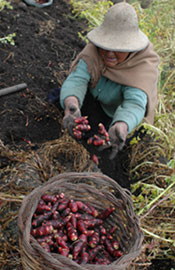News
Melting Glaciers Alter a Way of Life: Adapting to Harsh New Realities in Bolivia
- 16 November 2009
News
AMACHUMA CHICO, Bolivia — On the steep slopes leading down from the Huayna Potosi and Chacaltaya mountains lies a string of tiny communities where families eke out a meager living by keeping llamas, sheep and chickens and by growing small crops of potatoes and oca, a perennial plant grown in the central and southern Andes.
High above them, the Chacaltaya glacier that has sustained these activities is retreating at a completely unexpected pace?three times as quickly as was predicted just ten years ago?and will be gone in a generation. The glacier that once supported a ski resort is now reduced to a small chunk of snow and ice nestled just below the 18,000-foot summit.
With it, a web of life that depends on the waters seeping down from the glacier is irrevocably changing.
Many of the slopes are now farmed primarily by women?some of them in their seventies, some of them girls who should be in school. Though they manage to survive off the land, there’s nothing left over to sell, so many of the men have been forced to leave the mountains to take whatever work they can find in nearby La Paz or El Alto.
Village leader Felix Quispe, for example, feels deeply connected to the land his family has worked for generations. But now he spends much of his time in the city, selling toilet paper and cleaning windows.
“It is very sad,” he says, “Many people have left, houses are abandoned…. Husbands only come home maybe twice a month. It would be great to live like before and not be heartbroken every day.”
Meanwhile, Leocadia Quispe, born and raised in the Botijlaca community in the foothills of another retreating glacier, continues to grow potatoes and oca in what must be one of the harshest climates in South America. She is 60 years old, has eight children, but only one who lives nearby. The other seven have migrated to other parts of the country, “because there is no way to make a living here.”
Every day, she gets up at 4 a.m. and boils water to make chamomile tea. Breakfast is caya?oca that has been soaked in water wells for two months. For lunch, she and her daughter and grandchildren eat oca, potatoes and sometimes llama meat or mutton.
She says the family has to carry water from the river for their own use as well as to irrigate their crops. “There is less water now,” she says. “We used to be able to get water for irrigation from the streams that came down from the glacier. But the streams are no longer there, so now we supplement the water from a river further up in the valley.”
Mrs. Quispe carries the water up and down the steep slopes in five-litre containers, one in each hand. Lack of natural irrigation means less food for the animals. “Some of the llamas have starved to death,” she said. Leocadia says she doesn’t know what causes the melting of the glaciers. But she does know that there is less water for her family, the animals and the crops.

“Young people tend to leave these areas,” says Jaime Nadal, the UNFPA, United Nations Population Fund, representative in Bolivia. “Old women are typically left in the community having to perform harder and harder tasks to keep up the household. We already see mostly old women in many of these communities.”
Cultural traditions heighten the poignance of these changes. For one thing, the culture values the complementarity between men’s and women’s roles that is being disrupted by recent changes. And the people mourn the unraveling of their deep connections with Pachamama, Mother Earth. “This is a culture that is very much attached to the land,” says Mr. Nadal. “In our culture, the person is a person in the context of the field, the sun, the earth, the water.”
While the causes of some environmental phenomena are harder to pinpoint, the loss of tropical glaciers is directly associated with global warming, according to Robert Engelman, the lead author of this year’s State of World Population report, Facing a change world: Women, population and climate. “Women are on the front lines of many societies buffeted by climate change impacts?and research indicates they tend to be more vulnerable to these impacts,” Mr. Engelman states. This is one of the themes explored in the 2009 flagship report, which is being released worldwide on 18 November.
Almost all of the so-called tropical glaciers are located in the Andes. About 20 per cent of them are in Bolivia, and most of the rest are in Peru. Glaciers in the country’s Cordillera Real diminished by 84 square kilometers, or 24 per cent, between 1987 and 2004, according to Bolivia’s Ministry of Water and the Environment, and the disappearance continues at a worrisome rate. The speed of the snowmelt means that some of the country’s lowlands are experiencing floods that are worsening each year.
The loss of the glaciers also jeopardizes water supplies for the cities of La Paz and El Alto. “What will the world do when two million people will not have water for drinking?” asks Jose Gutierrez, a climate change expert in Bolivia.
“The world needs to know what is happening in Bolivia,” he adds. “We are losing something that is a human right, a source of life?water for drinking, for food, for the animals, for electricity. We also need to have a future, as any other people in this world.”
—reported by Trygve Olfarnes and Andi Gitow